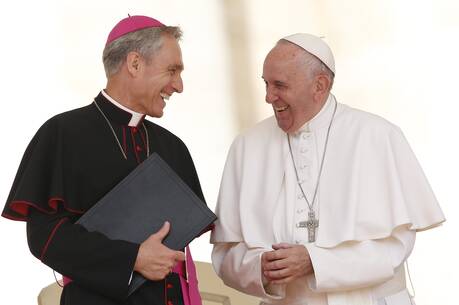Several years ago, when I worked for a company that specializes in socially responsible investing, I was assigned to identify potential clients in the greater Boston area. I began by contacting representatives of local Catholic institutions in the hope of discussing investing strategies that are consonant with the church’s social teaching. To my surprise, the people I contacted were skeptical about applying faith principles to economic decisions. “I don’t mix the two,” a deacon said. Another individual suggested that introducing social or faith values into investing was only a means of “softening” investment goals.
Unfortunately these were not isolated cases. Many people I spoke to at Catholic institutions were reluctant to endorse faith-based investing. How might this be overcome? The recent economic meltdown offers a fresh opportunity to re-examine Catholic investment strategies. The endowments at Catholic colleges, universities, hospitals and dioceses have suffered significant losses. Since these portfolios have shrunk, perhaps fresh ideas about what constitutes long-term, value investing will capture the interest of Catholic leaders. Now is the time to reassess how well the investment strategies of Catholic institutions reflect the church’s ecological and social values.
At Progressive Asset Management, the firm I worked for in Wellesley, Mass., we favored socially responsible investing (S.R.I. for short)—mutual funds that in addition to financial criteria employed a wide range of social and ethical standards to evaluate which stocks to invest in. S.R.I. managers carefully consider the labor conditions, environmental stewardship, executive compensation and other aspects of a business to determine its suitability. They also engage in dialogue with company leaders, an important practice known as shareholder advocacy, regarding ethical issues that inevitably influence the bottom line.
For those with whom I spoke—college trustees, parish and hospital administrators and archdiocesan leaders—steady return on investment was paramount. This singular focus seemed to have overshadowed other concerns central to Catholic social teaching, like sound ecology, human dignity and the common good. To be sure, some Catholic institutions, like the Archdiocese of Boston, employ screens to eliminate from their portfolios tobacco companies or pharmaceutical companies that produce abortifacients. Yet this approach fails to bring the whole spectrum of Catholic teaching to bear on investment decisions.
Multidimensional investment approaches, by contrast, identify liabilities and opportunities that traditional financial analysis too often ignores. A company’s impact on the environment may once have held little importance to mainstream investment companies, but they are now scrambling to catch up with socially responsible investing managers who long have understood how ecological factors play a key role in a business’s long-term fiscal viability. Such managers and, increasingly, mainstream investors are also applying ethical criteria to areas like pay scales and executive compensation. They look to companies like KLD Research & Analytics Inc., for example, which meticulously tracks (and scores) public companies’ history of product and service integrity, community relations and other stakeholder concerns.
A Useful Supplement
In evaluating the corporate health of investment holdings, an assessment of social and environmental performance is never a substitute for sound financial analysis. Instead it supplements traditional analysis in a way that gauges a company’s true financial strength. Matthew J. Kiernan, founder and chief executive officer of Innovest Strategic Value Advisors, is perhaps the most prominent advocate of this approach. In Investing in a Sustainable World: Why Green Is the New Color of Money on Wall Street, Kiernan writes, “Companies with superior performance and positioning on ‘sustainability’…achieved, on average, superior financial returns.” Kiernan’s argument is supported by studies in The SRI Advantage, edited by Peter Camejo. Investing that is connected to the needs of people and the planet has an excellent chance of flourishing. Indeed, Kiernan and Camejo contend that companies that embrace a sustainable approach to investing, socially and environmentally, will ultimately profit more than their purely market-oriented counterparts.
What, exactly, is meant by sustainability? The report of the United Nations’ Brundtland Commission on global economic development defines it as an effort that “meets the needs of the present without compromising the ability of future generations to meet their own needs.” The report, titled Our Common Future (1987), explains how economics and ecology are profoundly interrelated. When rainforests are destroyed for short-term profit, the health of ecosystems, including human populations, is compromised and the basis for all economic activity is severely weakened. The environmental decline of our oceans poses similar threats to sustainability. How are these challenges to be met?
Sound political leadership is essential. If applied prudently, government spending and tax credits can help guide business to make decisions in the long-term interest of the planet and the human community. Government has long provided direct or indirect subsidies for American industries—automobile manufacturing and computers, for instance—to ensure American industrial expansion, good jobs and fiscal stability. Under the Obama administration, the government is using these tools to promote sustainability. By its very nature as a catalyst for growth, the investment industry is well positioned to lead the ecological turnaround in business enterprise, and the White House appears to grasp this fact, too.
Van Jones, formerly special adviser to the White House on jobs, enterprise and innovation and author of Green Collar Economy: How One Solution Can Fix Our Two Biggest Problems, is a strong supporter of ecologically sound investing. He offers a seamless approach to people and planet in political and economic leadership. In his book he is focused on the dignity of workers and poor communities. Whether discussing organic urban gardens, retrofitting and weatherizing energy-intensive buildings or the entrepreneurial revolution in renewable power, Van Jones is mindful of the centrality of faith and justice in achieving sustainability, especially for people hurt the most by corporate globalization. He writes: “We can imagine formerly incarcerated people moving from jail cells to solar cells—helping to harvest the sun, heal the land, and repair their own souls. We can help local communities join hands—across lines of class and color—to honor the Earth, create new jobs, and reduce community violence.”
Tips for Catholic Institutions
For Catholic institutions, I recommend a threefold approach to increasing their endowments in a way that supports and enhances Catholic social teaching.
First, allocate 5 percent to 10 percent of assets in fixed-return “community investing” instruments. Community investing cultivates strong ties among low-income communities, nonprofit development companies and their institutional or individual investors. Unlike the now infamous “toxic mortgages,” community investing is built on good faith—and good credit. It welcomes the blurring of incentives enjoyed by traditional investors and philanthropists (make money and invest in social change!) and allows you to choose where you want your money to go.
The Calvert Group is one company that provides opportunities for community investment. With a 99.8 percent repayment rate and a modest return of 1 percent to 3 percent, depending on what the investor chooses, Calvert provides financial support to nonprofit development organizations like Boston Community Capital or Acción International. Boston Community Capital assists existing or start-up organizations with a social or environmental mission throughout the northeast United States, and Acción does the same throughout the developing world.
Second, invest at least 50 percent of assets in environmentally sustainable mutual funds or stocks. This is not as difficult as it may sound: more and more businesses are exploring ways to make their operations environmentally sustainable. Take, for instance, the pledge made by Wal-Mart’s senior executives in October 2005 to convert all its stores to 100 percent renewable energy and to achieve “zero waste” in all its operations. By some accounts, Wal-Mart is moving steadily in this direction. (Questions remain, of course, regarding its global labor practices.) Even General Electric, once notorious for its pollution of waterways, is making strides toward sustainability. The company has made a strong case—as has I.B.M.—for integrating green technologies like wind turbines and solar panels, with the emerging renewable energy grid connecting homes and businesses across the United States. Such a move could qualify G.E. as a “green company,” though, as with Wal-Mart, questions about its corporate practices remain. (New Alternatives Fund and Portfolio 21 are two green S.R.I. firms that do not include G.E. in their portfolios, largely because of the company’s continued participation in weapons manufacturing.)
Third, prioritize two or three issues for serious corporate engagement through dialogue and advocacy. Colleges, universities and dioceses should consider forming alliances with the New York-based Interfaith Center for Corporate Responsibility and the National Jesuit Committee for Investment Responsibility. For years both groups have been actively engaged in corporate campaigns for human rights, labor rights and the plight of H.I.V./AIDS patients. Some Jesuit universities—like Creighton, San Francisco and Marquette—have effectively collaborated with N.J.C.I.R. to raise the profile on important shareholder issues. The University of Notre Dame also has its own faith- and mission-related investment policy.
In certain circumstances, as during the anti-apartheid movement in the 1980s, the most effective way a Catholic institution can influence change may be to divest itself completely of a particular corporate stock. Santa Clara University has taken this approach in opposing the insidious practice of mountaintop removal in central Appalachia. In order to reach thin seams of coal more cheaply, approximately 800 square miles of the Appalachian Mountains have been destroyed with explosives. The large amount of debris is tossed into adjacent valleys by giant “drag line” equipment, smothering creeks and streams and causing flooding, among other ill effects. When students at Santa Clara called for the university to divest itself of its holdings in Massey Energy—the most egregious practitioner of mountaintop removal mining in Appalachia—Michael Engh, S.J., the university president, studied the issue and agreed to their request.
Patricia Daly, O.P., executive director of the Tri-State Coalition for Responsible Investment—the Catholic arm of the Interfaith Center for Corporate Responsibility in New York—espouses a different approach. As owner of Massey Energy stock, I.C.C.R. has begun to engage the company’s leaders regarding the environmental hazards of mountaintop removal and warns that complete divestment among conscientious investors would leave Massey with little incentive to change its practices. Shareholder advocacy may take time, proponents argue, but it can work. I.C.C.R., for example, has successfully convinced Coca-Cola to redress human rights abuses at factories in Colombia, and the National Jesuit Committee for Investment Responsibility has lobbied Abbott Laboratories to provide affordable AIDS testing and treatment in Africa.
While the wisdom of divestment can be debated, Catholic institutions can no longer ignore the wisdom of socially responsible investing. Owning stock in companies like Massey Energy for the sole purpose of earning a financial return is symptomatic of the narrowly focused analysis that has been all too common among mainstream investment companies. As representatives of religious institutions, we have permitted our faith commitments to become divorced from our financial goals and must now communicate our values more clearly than ever to our money managers.
In this century of planetary crisis, in which wars over water may prove even fiercer than those over oil, the importance of sustainability cannot be overemphasized. Unless the financial industry undergoes conversion, we will creep closer to the abyss of ecological disaster. With globalization we have grown accustomed to the predatory, indiscriminate flow of capital; but we have also seen resistance to these developments from indigenous peoples, environmental nongovernmental organizations, labor and faith groups. Now let us employ our Catholic values to facilitate our capital transformation. We can make our money work for all of us—for our planet, our schools, churches and hospitals, but especially for the poor, who have suffered the most because of all-too-conventional investing.









In the late 1970's the religion preached by Paul Ehrlich, the Club of Rome and others was of impending population explosion, shortages of materials and economic and social collapse. Late in his presidency Jimmy Carter deregulated trucking. Early in Ronald Reagan's presidency the price of natural gas was deregulated the effects were not just pronounced in the US, they were felt worldwide. In the mid 1980's the price of oil had collapsed more than 80% to $8/bbl. So, I ask, is removing a mountain top an more an aesthetic question, or an investment question?
If you have to fashion an investment policy around Catholic Social Teaching, one would avoid companies for which a primary business activity is the manufacture, sale and distribution of aborifacients or agents used specifically for the purpose of euthanasia. The US Conference of Catholic Bishops would also have you turn your bloodshot and jaundiced eye away from investing in manufacturers of armaments and weapons of mass anhilation. Perhaps your Board of Trustees should consider omitting from consideration CEO's of companies whose business activities are principally in these areas. It won't make you popular with ol' money-bags, but shunning is a very effective discipline for establishing cohesion to a set of social, ethical and moral norms.
Blending Social Benefit & Sound Investments
Doug Demeo’s article Prudential Investment (10/26) was on-point when he encouraged Catholic institutions unfamiliar with community investing to delve deeper and explore more “good faith-good credit” opportunities.
Some 26 years ago, a cluster of religious congregations in the New York metropolitan area did just that. These 27 organizations, active in the Tri-State Coalition for Responsible Investments, became trailblazers and actually established a community-based loan fund. The majority of the founding investors of the Leviticus 25:23 Alternative Fund were women’s religious orders and they, along with other faith denominations, are widely recognized for a vision of stewardship and empowerment that enriches community investing to this day.
So much more can – and needs – to be done to nurture faith-based community investing. According to the Interfaith Center on Corporate Responsibility (ICCR) “religious investors and institutions steward more than $100 billion.” Investing just a small percentage of this total in a community-based loan fund would unleash great potential and opportunities in underserved communities in our own country, and around the world.